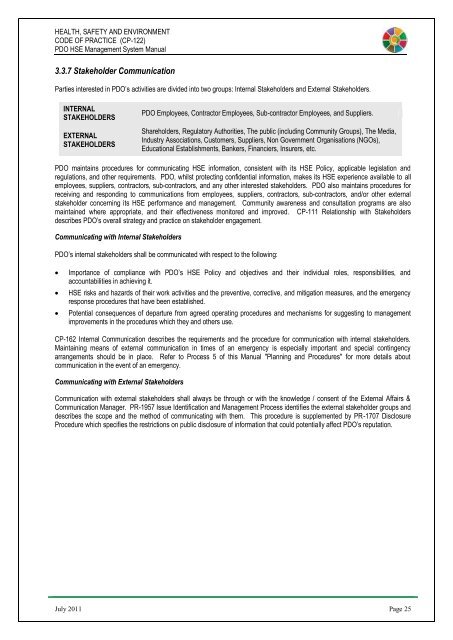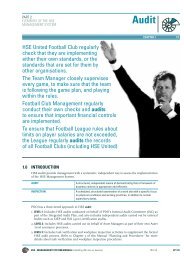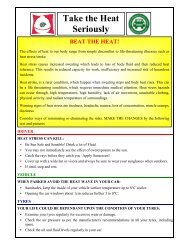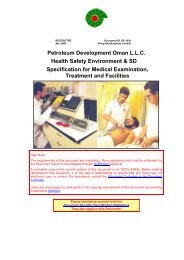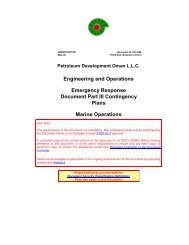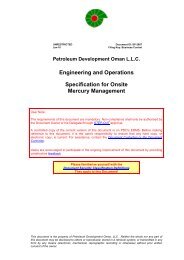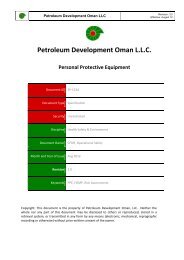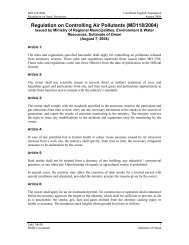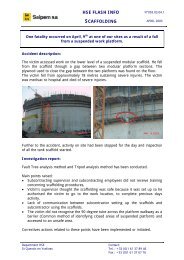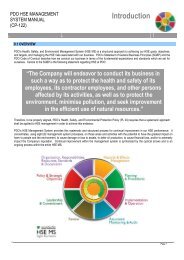CP-122 HSE Code of Practice - PDO
CP-122 HSE Code of Practice - PDO
CP-122 HSE Code of Practice - PDO
Create successful ePaper yourself
Turn your PDF publications into a flip-book with our unique Google optimized e-Paper software.
HEALTH, SAFETY AND ENVIRONMENT<br />
CODE OF PRACTICE (<strong>CP</strong>-<strong>122</strong>)<br />
<strong>PDO</strong> <strong>HSE</strong> Management System Manual<br />
3.3.7 Stakeholder Communication<br />
Parties interested in <strong>PDO</strong>‟s activities are divided into two groups: Internal Stakeholders and External Stakeholders.<br />
INTERNAL<br />
STAKEHOLDERS<br />
EXTERNAL<br />
STAKEHOLDERS<br />
<strong>PDO</strong> Employees, Contractor Employees, Sub-contractor Employees, and Suppliers.<br />
Shareholders, Regulatory Authorities, The public (including Community Groups), The Media,<br />
Industry Associations, Customers, Suppliers, Non Government Organisations (NGOs),<br />
Educational Establishments, Bankers, Financiers, Insurers, etc.<br />
<strong>PDO</strong> maintains procedures for communicating <strong>HSE</strong> information, consistent with its <strong>HSE</strong> Policy, applicable legislation and<br />
regulations, and other requirements. <strong>PDO</strong>, whilst protecting confidential information, makes its <strong>HSE</strong> experience available to all<br />
employees, suppliers, contractors, sub-contractors, and any other interested stakeholders. <strong>PDO</strong> also maintains procedures for<br />
receiving and responding to communications from employees, suppliers, contractors, sub-contractors, and/or other external<br />
stakeholder concerning its <strong>HSE</strong> performance and management. Community awareness and consultation programs are also<br />
maintained where appropriate, and their effectiveness monitored and improved. <strong>CP</strong>-111 Relationship with Stakeholders<br />
describes <strong>PDO</strong>‟s overall strategy and practice on stakeholder engagement.<br />
Communicating with Internal Stakeholders<br />
<strong>PDO</strong>‟s internal stakeholders shall be communicated with respect to the following:<br />
<br />
<br />
<br />
Importance <strong>of</strong> compliance with <strong>PDO</strong>‟s <strong>HSE</strong> Policy and objectives and their individual roles, responsibilities, and<br />
accountabilities in achieving it.<br />
<strong>HSE</strong> risks and hazards <strong>of</strong> their work activities and the preventive, corrective, and mitigation measures, and the emergency<br />
response procedures that have been established.<br />
Potential consequences <strong>of</strong> departure from agreed operating procedures and mechanisms for suggesting to management<br />
improvements in the procedures which they and others use.<br />
<strong>CP</strong>-162 Internal Communication describes the requirements and the procedure for communication with internal stakeholders.<br />
Maintaining means <strong>of</strong> external communication in times <strong>of</strong> an emergency is especially important and special contingency<br />
arrangements should be in place. Refer to Process 5 <strong>of</strong> this Manual "Planning and Procedures" for more details about<br />
communication in the event <strong>of</strong> an emergency.<br />
Communicating with External Stakeholders<br />
Communication with external stakeholders shall always be through or with the knowledge / consent <strong>of</strong> the External Affairs &<br />
Communication Manager. PR-1957 Issue Identification and Management Process identifies the external stakeholder groups and<br />
describes the scope and the method <strong>of</strong> communicating with them. This procedure is supplemented by PR-1707 Disclosure<br />
Procedure which specifies the restrictions on public disclosure <strong>of</strong> information that could potentially affect <strong>PDO</strong>‟s reputation.<br />
July 2011 Page 25


